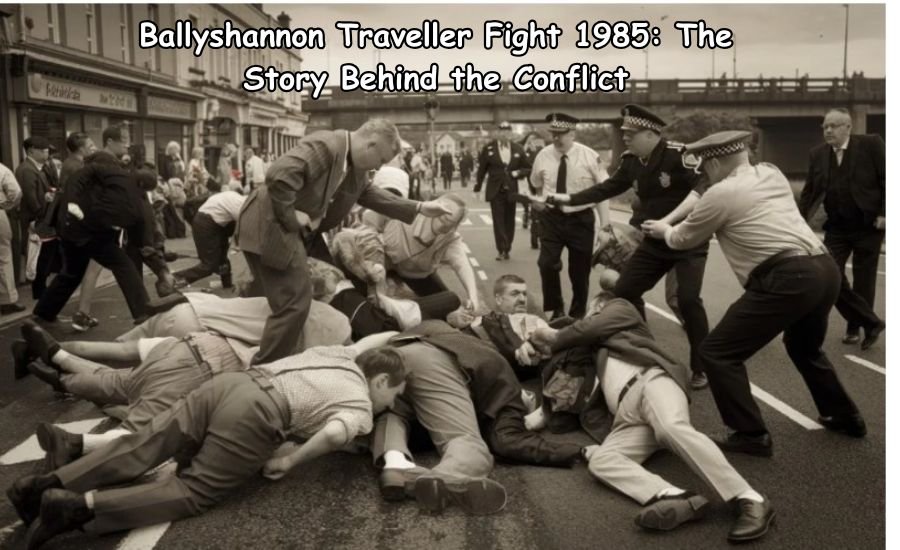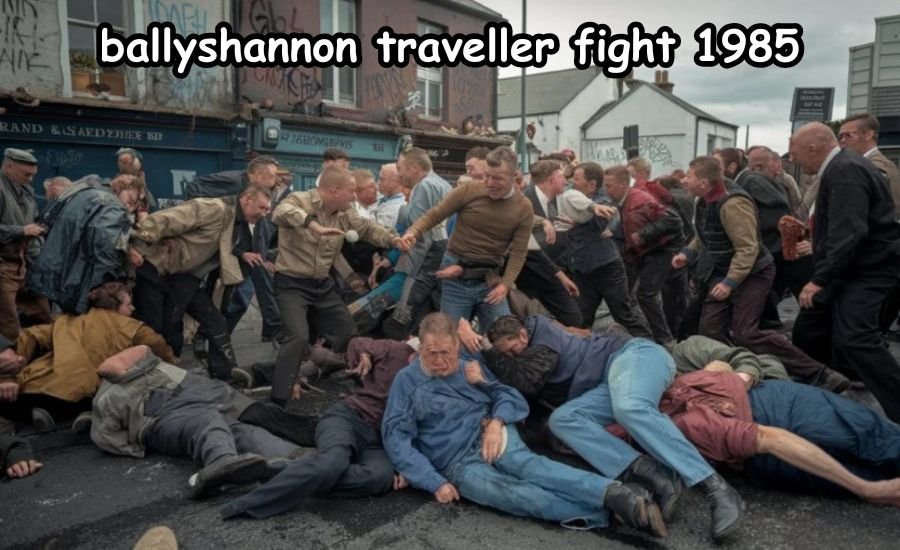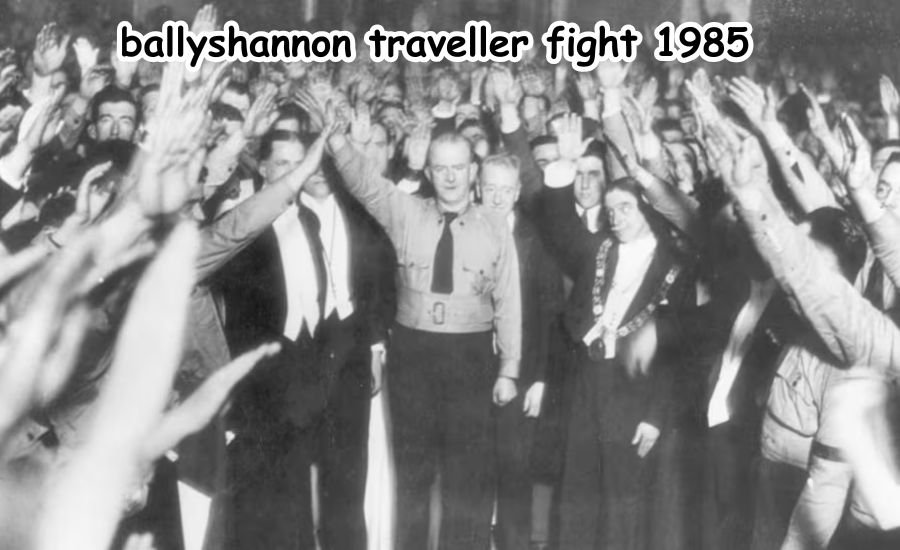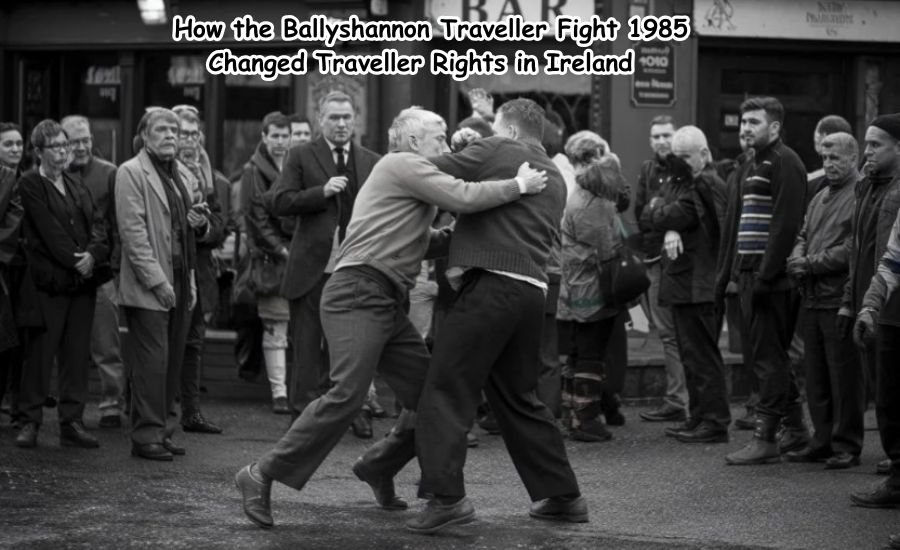In 1985, a violent clash known as the Ballyshannon Traveller Fight rocked the small town of Ballyshannon in County Donegal, Ireland. The incident became a flashpoint in Irish history, highlighting the deep-rooted tensions between the Traveller community and the settled population. At its core, the Ballyshannon Traveller Fight 1985 was about more than just a violent outburst; it reflected years of social and political struggles faced by Travellers and the community’s efforts to claim their identity amidst rising discrimination and misunderstandings.
The events leading up to the Ballyshannon Traveller Fight were marked by growing friction between the two groups. Reports of minor altercations, misunderstandings, and prejudices had slowly built up, creating an atmosphere ripe for conflict. Media coverage during this period often amplified the negative stereotypes, which contributed to the heightened emotions that eventually erupted into a full-scale fight. In the following sections, we’ll explore what triggered this clash, its impact on Irish society, and the lessons it leaves for the present day.
Ballyshannon Traveller Fight 1985: The Story Behind the Conflict

The Ballyshannon Traveller Fight of 1985 was a significant clash in a small Irish town that caught the attention of the entire country. This violent incident, which involved members of the Traveller community and local residents, was a result of deep-rooted tensions that had been building up over time. The conflict did not arise out of nowhere; rather, it was the culmination of multiple misunderstandings, differences in lifestyle, and long-standing grievances between the two communities. In the 1980s, Travellers faced discrimination and marginalization across Ireland.
They often lived on the outskirts of towns and faced barriers to accessing basic services, such as housing and education. These challenges made it difficult for Travellers to integrate with settled communities. Misconceptions about the Travellers’ way of life, which included a nomadic culture and close-knit family groups, led to resentment and mistrust from locals. Understanding the story behind the Ballyshannon Traveller Fight 1985 helps to provide insight into the larger issues that existed between Travellers and settled communities in Ireland during that period.
What Led to the Ballyshannon Traveller Fight 1985?
The Ballyshannon Traveller Fight 1985 did not happen overnight. Several issues contributed to this explosive conflict. At the core of the problem were economic difficulties and a lack of understanding between the communities. The mid-1980s was a tough time economically for Ireland, and Ballyshannon was no exception. High unemployment rates affected both settled residents and the Traveller community, creating competition for jobs and resources. When people are struggling financially, tensions can rise quickly, especially between groups with different lifestyles and needs.
Travellers often lived in temporary campsites or poorly developed housing areas, which caused friction with settled residents. Small conflicts related to land use, property boundaries, and misunderstandings over social norms added to these tensions. Some locals accused Travellers of causing trouble, while Travellers felt unfairly targeted and excluded. These everyday disputes eventually snowballed, leading to increased hostility and resentment from both sides.
The Social and Political Backdrop of the Ballyshannon Traveller Fight 1985
In 1985, the social and political landscape in Ireland was turbulent, with economic hardships and social inequality affecting many communities. Travellers were among those most impacted by these struggles. The government attempted to introduce measures to improve conditions for the Traveller community, such as housing initiatives and social services. However, these efforts often missed the mark and failed to address the root causes of discrimination and marginalization.
The Ballyshannon Traveller Fight 1985 must be viewed against this backdrop of societal change. Tensions between Travellers and settled communities reflected larger issues of inequality and prejudice. The incident revealed how deep these divisions were, highlighting the need for better communication and more inclusive policies. The social and political climate of 1985 set the stage for the fight, which became a flashpoint for these broader societal issues.
How the Ballyshannon Traveller Fight 1985 Shaped Irish Community Relations
The Ballyshannon Traveller Fight 1985 had a profound impact on how communities in Ireland viewed and interacted with each other. Before the incident, relations between the Traveller community and the settled residents were already strained due to economic challenges and differences in lifestyles. The fight in Ballyshannon brought these tensions into the national spotlight, forcing many people to confront the deep-seated prejudices and misunderstandings that existed between the two groups.
However, the Ballyshannon Traveller Fight 1985 also served as a wake-up call for many. It highlighted the urgent need to address the issues of inequality and social division that existed in Irish society. Over time, this incident led to efforts aimed at promoting dialogue and understanding between the two communities. Although progress was slow, it marked the beginning of a gradual shift towards recognizing and addressing the challenges faced by the Traveller community.
Lessons Learned from the Ballyshannon Traveller Fight 1985

The Ballyshannon Traveller Fight 1985 offers valuable lessons about the importance of understanding and addressing the root causes of social conflicts. One key takeaway from the incident is the need for open dialogue and empathy between different communities. The fight was the result of longstanding tensions, misunderstandings, and prejudices that were never properly addressed. It showed how crucial it is to have open lines of communication to bridge gaps between communities with different cultures and lifestyles.
Lastly, the Ballyshannon Traveller Fight 1985 emphasized the importance of proactive measures to address systemic issues like discrimination and social exclusion. Instead of waiting for conflicts to escalate, it’s essential to tackle these problems at their roots by promoting social programs, fair policies, and genuine efforts to build understanding and trust. The fight serves as a reminder that lasting change requires ongoing efforts and collaboration between all members of society.
Understanding the Tensions in the Ballyshannon Traveller Fight 1985
To fully grasp what happened during the Ballyshannon Traveller Fight 1985, it’s essential to understand the underlying tensions that led to the conflict. The Traveller community in Ireland has a distinct culture, marked by a nomadic lifestyle, strong family ties, and unique traditions. However, this way of life often clashed with the norms and expectations of the settled population. Many locals viewed Travellers as outsiders and felt that their presence was disruptive, which created a sense of unease.
Economic hardships also played a major role in escalating tensions. During the 1980s, Ireland was experiencing financial difficulties, and both settled residents and Travellers struggled to find stable employment and housing. When resources are scarce, competition for those resources can lead to resentment, particularly when there are visible differences between the groups competing for them.
Impact of the Ballyshannon Traveller Fight 1985 on the Traveller Community
The Ballyshannon Traveller Fight 1985 had a lasting impact on the Traveller community in Ireland. The fight brought to light the discrimination and exclusion that Travellers faced daily, but it also increased the stigma against them. Media reports of the incident often portrayed Travellers negatively, reinforcing existing stereotypes and deepening the divide between the communities. This negative portrayal affected how Travellers were treated, making it even harder for them to integrate into society.
Following the Ballyshannon incident, many Travellers felt even more isolated from the settled community. Trust was eroded, and tensions between the groups were at an all-time high. Many Travellers feared reprisals or further conflicts, which made it difficult for them to feel safe or welcomed in towns like Ballyshannon. The incident highlighted the need for greater understanding and support to help the Traveller community gain acceptance and respect.
The Role of Media in the Ballyshannon Traveller Fight 1985
The media played a crucial role in shaping public perception during the Ballyshannon Traveller Fight 1985. News coverage of the conflict often focused on the violence and chaos, but it sometimes lacked context or balanced reporting. Headlines highlighted the negative aspects, such as property damage and arrests, without delving into the underlying causes of the tension. This led many readers and viewers to form biased opinions about the Traveller community, which only deepened the divide between them and the settled population.
Many media reports at the time depicted the Travellers as instigators of trouble, focusing on stereotypes and reinforcing long-held prejudices. By sensationalizing the conflict, the media inadvertently fueled anger and mistrust among locals. These reports often ignored the systemic issues like poverty, discrimination, and lack of adequate services for the Travellers, instead choosing to sensationalize individual incidents. This narrow coverage painted an unfair and incomplete picture of the Traveller community.
Legal Actions and Repercussions Following the Ballyshannon Traveller Fight 1985
In the aftermath of the Ballyshannon Traveller Fight 1985, local authorities were forced to intervene and take legal action against those involved. Numerous arrests were made following the clash, as police tried to restore order in the town. Individuals from both the Traveller community and the settled population faced charges related to property damage, assault, and disorderly conduct. These legal proceedings reflected the scale and intensity of the conflict, as the community sought to address the chaos that had unfolded.
While the arrests addressed some of the immediate violence, the broader legal and political repercussions were more complex. The fight drew attention to the discrimination and social exclusion faced by the Traveller community, highlighting the inadequacies of existing policies. Although there were calls for reform and greater protections for Travellers, the political response was slow. Issues like access to housing, education, and basic services remained largely unresolved, leading to ongoing tensions in the years following the incident.
Changes in Public Perception After the Ballyshannon Traveller Fight 1985

After the Ballyshannon Traveller Fight 1985, public perception of the Traveller community became a hot topic in Ireland. The incident highlighted the existing prejudice against Travellers and forced many people to confront their biases. While some individuals continued to hold negative views, the fight also sparked conversations about the need for greater empathy and understanding. Slowly, awareness of the challenges faced by the Traveller community began to grow.
However, changing public perception was not an easy task. Deep-seated biases and historical grievances could not be erased overnight. The legacy of the Ballyshannon Traveller Fight 1985 underscored the importance of consistent and long-term efforts to challenge stereotypes and promote social harmony. Although progress was slow, the fight helped spark discussions that continue to shape Ireland’s approach to diversity and inclusion today.
Things You Have To Know: Scrotum-neck-mitch-mcconnell
Government Response and Policy Changes After the Ballyshannon Traveller Fight 1985
The Ballyshannon Traveller Fight 1985 prompted the government to re-evaluate its approach towards the Traveller community. Before the incident, policies aimed at Travellers were often fragmented and failed to address the root causes of their marginalization. The clash in Ballyshannon highlighted the urgent need for more comprehensive and inclusive policies. In response, the government began looking into housing, education, and social services as key areas for improvement.
Following the incident, the government introduced several initiatives to improve the living conditions of Travellers. One of the main focuses was on providing better housing options, as inadequate housing had been a major source of tension between Travellers and the settled population. While these efforts showed some progress, they were often met with resistance from locals and did not fully resolve the deep-rooted issues that existed.
Legacy of the Ballyshannon Traveller Fight 1985: Lessons for Today
The Ballyshannon Traveller Fight 1985 left behind a complex legacy that still holds relevance today. This event underscored the importance of addressing prejudice and creating spaces for open dialogue between different communities. The conflict highlighted the dangers of allowing stereotypes and misunderstandings to fester unchecked. For many, it was a harsh reminder of the consequences of failing to promote empathy and respect between groups with different ways of life.
One of the key lessons from the Ballyshannon Traveller Fight is the need for proactive measures to address the root causes of social tension. Simply responding to conflicts after they have escalated is not enough. Long-term solutions require efforts to promote cultural understanding, fair representation, and policies that address the specific needs of marginalized communities. This approach helps prevent conflicts like the one in Ballyshannon and fosters a more cohesive society.
The Role of Advocacy and Activism After the Ballyshannon Traveller Fight 1985
Following the Ballyshannon Traveller Fight 1985, advocacy groups and activists became more vocal about the challenges faced by the Traveller community. The violent clash highlighted the deep divisions within society and the urgent need to address discrimination and marginalization. This period saw a rise in efforts from advocacy groups pushing for better representation and the rights of Travellers in Ireland. Activists sought to shed light on the inequalities faced by Travellers and to promote policies that would protect their rights.
These efforts were not without challenges. Overcoming generations of mistrust and deeply ingrained biases required patience and persistence. However, the activism following the Ballyshannon Traveller Fight 1985 marked a significant turning point in raising awareness about Traveller issues. It also helped build momentum for social change, contributing to gradual improvements in policy and public attitudes towards the Traveller community.
How the Ballyshannon Traveller Fight 1985 Changed Traveller Rights in Ireland

The Ballyshannon Traveller Fight of 1985 played a pivotal role in sparking discussions about Traveller rights in Ireland. Before this incident, Travellers were often excluded from mainstream policy discussions, and their concerns were rarely prioritized by the government. The violent clash in Ballyshannon drew national attention to the challenges faced by the Traveller community and exposed the discrimination they experienced daily.
The legacy of the Ballyshannon Traveller Fight 1985 continues to shape discussions about Traveller rights in Ireland today. It serves as a reminder of the importance of inclusivity and the need to listen to marginalized communities. While significant progress has been made since 1985, ongoing efforts are still necessary to ensure that Travellers are treated with respect and given equal opportunities in Irish society.
Reflecting on the Ballyshannon Traveller Fight 1985: Building a More Inclusive Future
Reflecting on the Ballyshannon Traveller Fight of 1985 offers valuable insights into the importance of building a more inclusive and understanding society. The violent clash revealed the deep divisions between the Traveller community and the settled population, exposing the consequences of unchecked prejudice and lack of communication. It showed how crucial it is to address misunderstandings and promote empathy between different groups.
Today, the legacy of the Ballyshannon Traveller Fight 1985 serves as a call to action for individuals, communities, and policymakers. It reminds us that creating a more inclusive society requires ongoing efforts to address systemic inequalities and promote understanding between different cultures. By learning from the past, Ireland can continue working towards a future where all communities can coexist peacefully and with mutual respect.
Conclusion
TheBallyshannon Traveller Fight 1985 was a significant moment in Ireland’s history that showed the challenges between the Traveller community and the settled population. This event brought to light deep issues like prejudice, discrimination, and a lack of understanding between different groups. The fight wasn’t just about one incident of violence; it was a reflection of the tensions that had been building up over time. It showed how important it is to deal with these underlying problems and not just focus on the conflicts that arise from them.
In the years following the Ballyshannon Traveller Fight 1985, there were efforts to make things better for Travellers and promote more understanding. Advocacy groups worked hard to challenge negative stereotypes and push for fairer treatment and opportunities for Travellers. The government also began to pay more attention to the needs of the Traveller community, making some improvements in housing, education, and services. While progress has been made, the lessons from the Ballyshannon incident still remind us that building a more inclusive society takes ongoing efforts.
Read You Have To Know: Bitcoin-spiral-chart-2024
FAQs
What was the Ballyshannon Traveller Fight 1985?
TheBallyshannon Traveller Fight 1985 was a violent confrontation between members of the Traveller community and settled residents in Ballyshannon, County Donegal, Ireland.
What caused the fight?
The fight was fueled by long-standing disputes and tensions between Travellers and local residents, exacerbated by issues like theft, vandalism, and economic hardship
How did the media portray the Ballyshannon Traveller Fight 1985?
Media coverage of the Ballyshannon Traveller Fight often focused on the violence and chaos, which sometimes led to negative stereotypes about Travellers. ies.
Did theBallyshannon Traveller Fight 1985 lead to any legal actions?
Yes, following the fight, local authorities conducted investigations, leading to arrests and legal proceedings against individuals involved in the violence.
What impact did the fight have on Traveller rights?
The Ballyshannon Traveller Fight 1985 brought national attention to the challenges faced by the Traveller community.
How did the Traveller community respond after the fight?
The Traveller community and advocacy groups worked to promote a better understanding of Traveller culture and address the stereotypes perpetuated by the media.
What lessons can be learned from the Ballyshannon Traveller Fight?
The fight serves as a reminder of the importance of addressing underlying social issues, promoting dialogue, and fostering empathy between different communities.
Have there been changes in public perception of Ballyshannon Traveller Fight 1985?
Yes, while some negative stereotypes persist, there has been a gradual shift in public perception due to advocacy efforts.
What ongoing challenges do Travellers face today?
Despite improvements, Travellers still face challenges such as discrimination, inadequate housing, and limited access to education and services.








